Digital music streaming services like Spotify and Apple Music enhance accessibility and reshape listening trends. They provide vast music libraries, promote global diversity, and influence artist distribution strategies. Accessibility features ensure enjoyment for all users, while emerging trends focus on personalization and technology integration. Additionally, legal considerations and regional preferences impact consumption patterns and artist revenues in this evolving landscape.
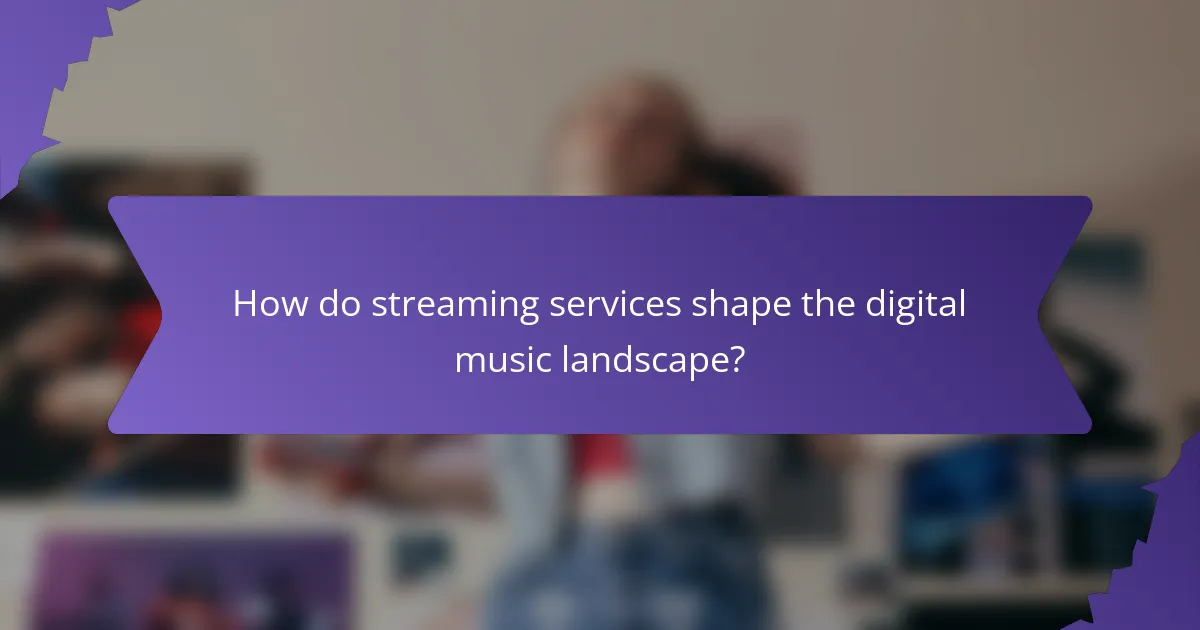
How do streaming services shape the digital music landscape?
Streaming services significantly influence the digital music landscape by enhancing accessibility and shaping listening trends. They provide instant access to vast music libraries, allowing users to discover new artists and genres easily. As a result, streaming platforms like Spotify and Apple Music have become primary sources for music consumption, surpassing traditional media.
The shift to streaming has transformed how artists distribute their music, often prioritizing singles and playlists over full albums. This change reflects evolving listener preferences for shorter, more frequent releases. Additionally, data analytics from these platforms help artists understand audience behavior, driving targeted marketing strategies.
Streaming services also foster global music exposure, enabling artists from diverse backgrounds to reach international audiences. This democratization of music distribution challenges traditional gatekeepers in the industry, promoting a wider variety of sounds and styles.
Overall, streaming services are reshaping the digital music landscape by making music more accessible, influencing artist strategies, and promoting global diversity in music consumption.
What are the leading platforms for music streaming?
The leading platforms for music streaming include Spotify, Apple Music, Amazon Music, YouTube Music, and Tidal. These services dominate the market due to their extensive music libraries and user-friendly interfaces. Spotify leads with over 500 million users, offering personalized playlists and podcasts. Apple Music integrates seamlessly with Apple devices and provides exclusive releases. Amazon Music caters to Prime members with additional features. YouTube Music leverages its vast video library, while Tidal emphasizes high-fidelity audio quality.
How do subscription models differ among streaming services?
Subscription models among streaming services vary primarily in pricing, content access, and user experience. Some services offer tiered pricing based on audio quality, while others provide ad-supported free tiers. For example, Spotify has a free version with ads and a premium tier without ads, while Apple Music operates solely on a paid subscription model.
Additionally, some platforms offer family or student discounts, enhancing accessibility. Unique attributes include exclusive content deals, such as live performances or artist collaborations, which can attract subscribers. Rarely, services may introduce limited-time offers or bundled subscriptions with other services, creating a competitive edge.
Overall, understanding these differences helps consumers choose the best service for their needs.
What role do algorithms play in music discovery?
Algorithms significantly enhance music discovery by personalizing recommendations based on user preferences and listening habits. They analyze vast amounts of data, including song attributes and user interactions, to curate playlists that match individual tastes. This tailored approach increases user engagement and satisfaction, making it easier to explore new genres and artists. Streaming services utilize machine learning algorithms to continually refine suggestions, ensuring that users receive fresh content aligned with their evolving preferences. This dynamic process fosters a deeper connection between listeners and the music they love.
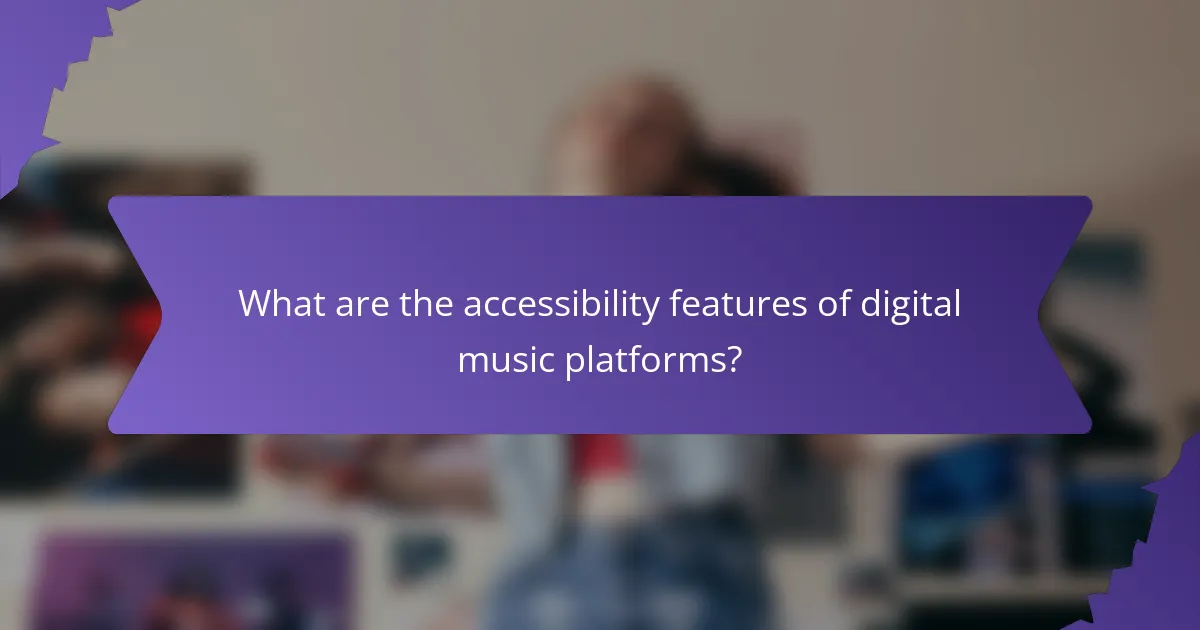
What are the accessibility features of digital music platforms?
Digital music platforms offer various accessibility features to enhance user experience for individuals with disabilities. These features include screen reader compatibility, voice control, customizable text sizes, and high-contrast modes.
Additionally, many platforms provide keyboard shortcuts for easier navigation and support for alternative input devices. Some services also include features for hearing-impaired users, such as lyrics display and visualizations that accompany audio.
As a result, these accessibility options ensure that everyone can enjoy music regardless of their physical limitations.
How do streaming services accommodate users with disabilities?
Streaming services accommodate users with disabilities through various accessibility features. These include closed captioning, audio descriptions, and screen reader compatibility. Services like Spotify and Apple Music offer customizable playback options and interface adjustments to enhance usability. Additionally, platforms prioritize user feedback to improve their accessibility measures continually.
What are the language options available in popular streaming apps?
Popular streaming apps offer multiple language options, catering to diverse audiences. Services like Spotify, Apple Music, and Amazon Music provide content in various languages, including English, Spanish, French, and more. This accessibility enhances user experience and broadens audience reach. Additionally, some platforms allow users to select language preferences for interfaces and lyrics, further personalizing the listening experience.
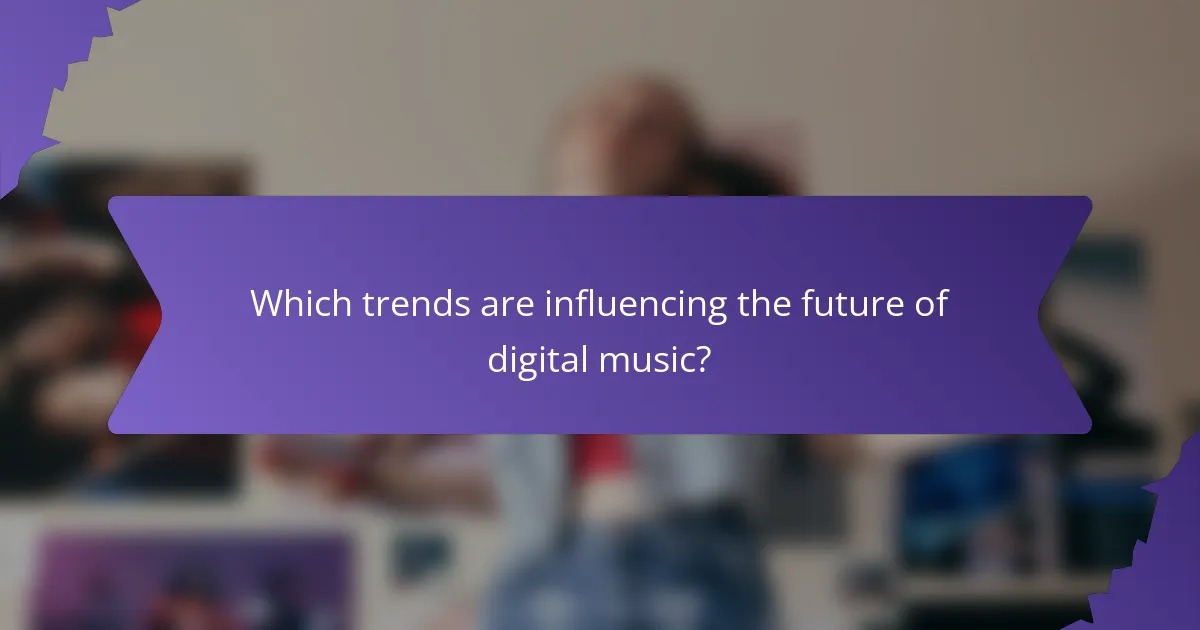
Which trends are influencing the future of digital music?
Emerging trends are reshaping the future of digital music, focusing on personalization, technology integration, and user experiences. Increased use of artificial intelligence enhances music recommendations, while immersive technologies like virtual reality create new listening environments. Social media platforms are evolving into music discovery hubs, influencing how artists connect with audiences. Additionally, the rise of decentralized music platforms empowers artists by offering fairer revenue models.
How is social media impacting music consumption?
Social media significantly influences music consumption by enhancing accessibility and promoting trends. Platforms like Instagram and TikTok amplify song visibility, driving streaming numbers. Viral challenges often lead to increased downloads and streams, showcasing the power of user-generated content. Moreover, artists leverage social media for direct engagement, fostering fan loyalty and real-time feedback. This shift towards digital interaction reshapes how music is marketed and consumed, making it more immediate and personalized.
What innovations are emerging in audio technology?
Emerging innovations in audio technology focus on enhanced streaming services, improved accessibility, and evolving trends. Streaming platforms are adopting spatial audio for immersive experiences, while AI-driven algorithms personalize music recommendations. Accessibility features are expanding, enabling users with disabilities to enjoy music seamlessly. Additionally, vinyl resurgence highlights consumer interest in analog formats alongside digital advancements.
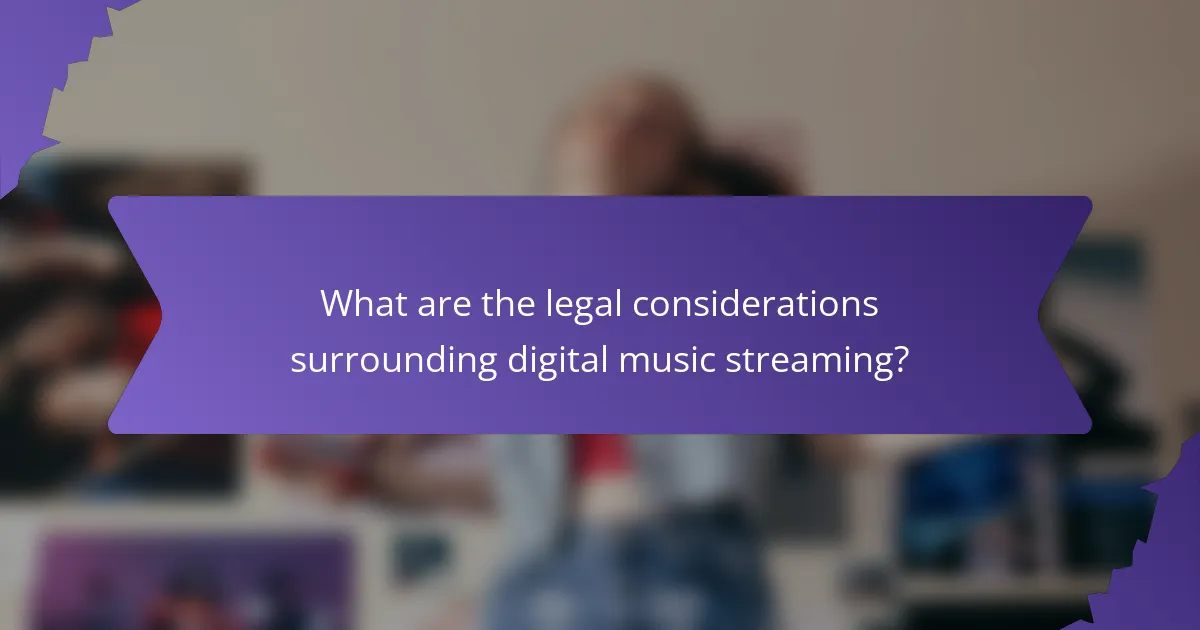
What are the legal considerations surrounding digital music streaming?
Digital music streaming involves various legal considerations, including copyright laws and licensing agreements. Streaming services must secure rights from artists and record labels to distribute music legally. Compliance with these regulations ensures fair compensation for creators while providing users access to vast music libraries. Additionally, issues like user data privacy and regional licensing variations further complicate the legal landscape. Understanding these aspects is crucial for both providers and consumers in the digital music ecosystem.
How do copyright laws affect streaming services?
Copyright laws significantly influence streaming services by dictating content availability and licensing costs. These laws ensure that artists receive compensation, impacting the pricing models of platforms. Streaming services must navigate complex regulations to provide access to music while adhering to copyright protections. As a result, they often negotiate licensing agreements, which can vary by region and affect the catalog offered to users. This legal framework shapes the overall accessibility and trends within the digital music landscape.
What are the challenges of licensing music for digital platforms?
Licensing music for digital platforms presents several challenges. These include complex negotiations with rights holders, varying regional laws, and the need for clear royalty distribution models. Additionally, the rapid evolution of technology complicates compliance with licensing agreements. As a result, many platforms struggle to balance legal requirements with user accessibility and content availability.
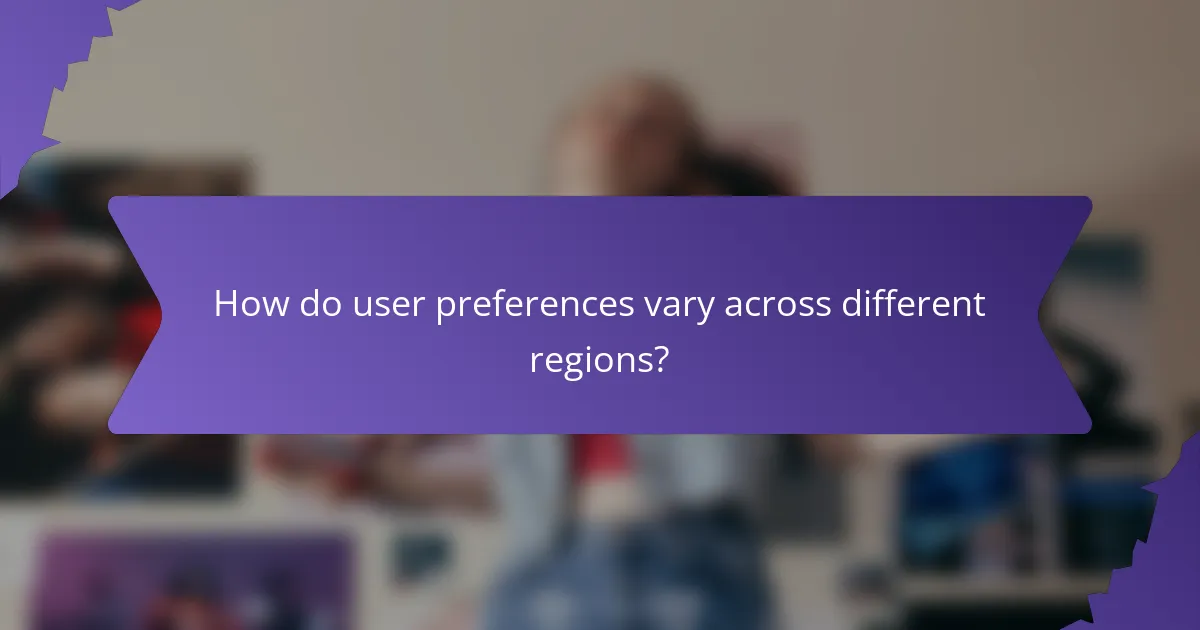
How do user preferences vary across different regions?
User preferences for digital music vary significantly across regions due to cultural influences, internet accessibility, and platform popularity. For instance, North America favors Spotify and Apple Music, while Latin America shows a strong preference for localized services like Claro Música. In Asia, platforms such as JioSaavn dominate in India, reflecting regional music tastes. Additionally, internet speeds and mobile data costs impact streaming habits; regions with higher costs tend to favor offline listening options.
What genres are most popular in various markets?
Pop genres dominate digital music markets, with hip-hop, pop, and electronic leading in streaming services. Regional variations exist, with Latin music gaining traction in the U.S. and K-pop thriving in Asia. The accessibility of streaming platforms has fueled these trends, allowing diverse genres to reach wider audiences. As a result, niche genres are also finding their place, reflecting unique cultural influences across different markets.
How do cultural influences shape music consumption habits?
Cultural influences significantly shape music consumption habits by affecting preferences and access. Different cultures prioritize various genres, impacting streaming trends and service popularity. For instance, hip-hop dominates in urban areas, while folk music thrives in rural communities. Accessibility also varies; regions with high internet penetration favor streaming services, enhancing music discovery. Cultural events and social media trends further influence listening habits, creating a dynamic landscape in digital music consumption.

What are the economic impacts of streaming on artists?
Streaming services significantly alter artists’ economic landscapes by shifting revenue models from album sales to per-stream payments. This change often results in lower income for many musicians, particularly independent artists.
The average payout per stream ranges from $0.003 to $0.005, making it challenging for artists to sustain a living solely through streaming. As a result, many artists diversify their income through merchandise sales, live performances, and crowdfunding.
Furthermore, streaming enhances accessibility, allowing artists to reach global audiences. This exposure can lead to increased fan engagement and opportunities for collaborations, ultimately benefiting their careers despite the lower direct revenue from streams.
In summary, while streaming services democratize music access and expand audience reach, they also present economic challenges that require artists to adapt their business strategies.
How do revenue models affect artist earnings?
Revenue models significantly influence artist earnings by determining how income is generated from digital music. Streaming services typically use subscription and ad-supported models, impacting payout rates for artists.
For example, subscription services like Spotify offer artists a share based on total streams, while ad-supported platforms like YouTube pay per ad view. The average payout per stream can be as low as $0.003, significantly affecting overall earnings.
Additionally, accessibility trends, such as mobile streaming and global reach, expand audience size but can dilute individual earnings due to lower per-stream payouts. As a result, artists increasingly rely on merchandise and live performances to supplement their income.
In summary, the revenue model shapes the financial landscape for artists, influencing how they earn from their music and necessitating diversification of income sources.
What alternatives exist for supporting musicians in the digital age?
Musicians can explore various alternatives to traditional support in the digital age. Crowdfunding platforms allow fans to directly fund projects, while subscription services enable artists to receive consistent income. Merchandise sales through online stores provide additional revenue. Social media engagement fosters community support, and virtual concerts expand audience reach. These methods enhance accessibility and empower musicians to thrive independently.
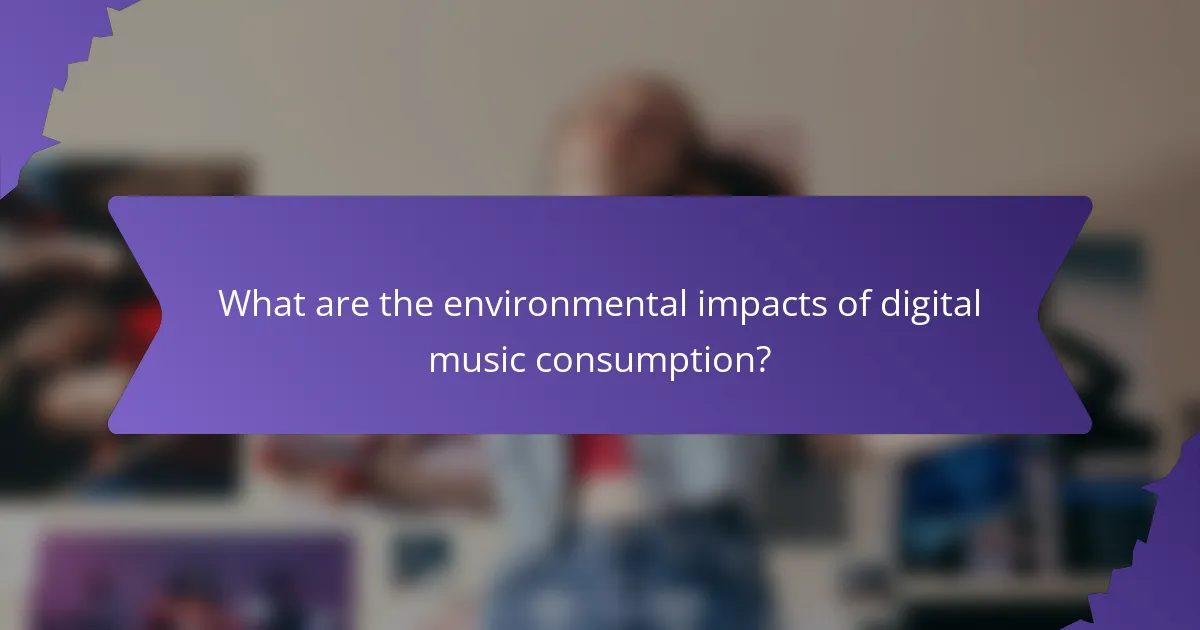
What are the environmental impacts of digital music consumption?
Digital music consumption has significant environmental impacts primarily due to energy use and electronic waste. Streaming services require substantial server energy, contributing to carbon emissions. For instance, a study estimates that streaming one hour of music can produce around 0.2 kg of CO2. Additionally, the production and disposal of devices for music consumption generate electronic waste, with millions of tons discarded annually. These factors highlight the need for sustainable practices in the digital music industry.
How does streaming compare to physical media in terms of carbon footprint?
Streaming services generally have a lower carbon footprint compared to physical media. Streaming relies on data centers and internet infrastructure, which consume energy but can be optimized for efficiency. In contrast, physical media production involves manufacturing, transportation, and disposal, contributing significantly to carbon emissions. Streaming can be more sustainable if powered by renewable energy sources.
What initiatives are being taken to promote sustainability in the music industry?
The music industry is advancing sustainability through various initiatives. Streaming services are adopting eco-friendly practices by using renewable energy for data centers. Many artists and labels are promoting digital releases to reduce physical production waste. Collaborations with environmental organizations are increasing awareness and funding for sustainable projects. Additionally, some platforms are implementing carbon offset programs to mitigate their environmental impact.
What best practices can users adopt for responsible streaming?
Users can adopt best practices for responsible streaming by prioritizing legal access, managing data usage, and supporting artists. Legal streaming services ensure that artists receive fair compensation. Users should also monitor their data consumption to avoid overages, especially on mobile networks. Additionally, creating playlists and engaging with artists on social media can enhance the streaming experience while fostering a responsible community.